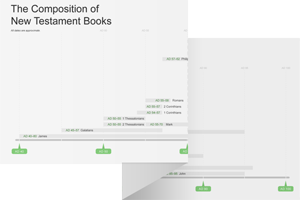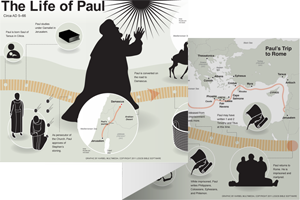1:1–10 Paul visited Thessalonica during his second missionary journey (ca. ad 49–51; Acts 17:1–9). Preaching in the local synagogue, Paul converted many Thessalonians—both Jew and Gentile—to Christianity (Acts 17:2–4). Some Jews, however, became jealous and caused a disturbance in the city (Acts 17:5). They accused Paul of claiming there was another king, named Jesus (Acts 17:7)—an act of treason against the Roman emperor. Before they could arrest him, Paul was sent away, leaving behind a community of new believers. Concerned they might not withstand the threat of persecution, Paul sent Timothy to encourage the Thessalonians (1 Thess 3:2). Timothy reported back that they endured the persecution but now had concerns about the Lord’s return. In addition, some believers continued to engage in sexual immorality, while others refused to work for a living. Paul wrote this letter in response to Timothy’s report. He likely wrote the letter from Corinth between ad 50–51 (compare Acts 18:1), making it one of the earliest books of the nt. |
 Introduction to 1 Thessalonians
Introduction to 1 Thessalonians
 Paul: A Life of Redemption and Transformation
Paul: A Life of Redemption and Transformation
 Pauline Self-Designations Table
Pauline Self-Designations Table
Silvanus Silas, also known as Silvanus, was a well-respected leader from the Jerusalem church who accompanied Paul on his second missionary journey (Acts 15:22, 40; 16:16–40). Paul likely includes Silas as a cosender of this letter because he also ministered to the Thessalonians (Acts 17:4, 14).
Timothy Half-Gentile, half-Jewish disciple and companion of Paul. Paul includes Timothy as a cosender because, like Silvanus, the Thessalonians knew him (Acts 17:14).
as a cosender because, like Silvanus, the Thessalonians knew him (Acts 17:14).
Thessalonians The city of Thessalonica was located in the Roman province of Macedonia (modern-day Greece). Its harbor and proximity to a major highway (Via Egnatia) made it a strategic location for Paul’s ministry in Macedonia.
was located in the Roman province of Macedonia (modern-day Greece). Its harbor and proximity to a major highway (Via Egnatia) made it a strategic location for Paul’s ministry in Macedonia.
Grace to you and peace Paul’s typical greeting throughout his letters (e.g., Rom 1:7; Phil 1:2). It summarizes his gospel message: God’s work through Christ (“grace”) brings people into a harmonious relationship with God and one another (“peace”).
1:2 We give thanks Paul’s letters often follow conventions for ancient letter-writing by including a prayer for the recipients. Here Paul thanks God for the Thessalonians’ faith, which continued to grow despite his absence (1 Thess 2:17–3:5).
 Prayers in Paul’s Letters Table
Prayers in Paul’s Letters Table
1:3 work of faith and labor of love and steadfastness of hope Faith, love, and hope are the three core Christian virtues (1 Cor 13:13; 1 Thess 5:8). They serve as evidence of the Thessalonians’ salvation and the effectiveness of missionary efforts among them.
1:4 brothers The Greek word for “brothers” (adelphoi) addresses both male and female believers.
1:5 power Refers to the power evident in Paul’s preaching. It may also refer to God’s miraculous power among the Thessalonians, which confirmed the integrity of his gospel message.
what sort of people we became among you Paul and his companions worked while they lived among the Thessalonians (2:9). He reminds them of this to address false accusations about the integrity of his missionary efforts. Some unnamed people may have claimed that Paul was no different from traveling philosophers who give speeches to make money. But Paul worked while living with the Thessalonians, leaving them an example to follow. Later he reminds the Thessalonians that he and his coworkers served among them with gentleness and loving care (2:7–8).
1:6 imitators In joyfully enduring persecution, the Thessalonians imitated Paul, his companions, and the Lord Jesus (compare Matt 5:11–12; Acts 5:41).
affliction Refers to the opposition and persecution experienced by the believers in Thessalonica (3:3–4, 7; 2 Thess 1:4, 6–7).
experienced by the believers in Thessalonica (3:3–4, 7; 2 Thess 1:4, 6–7).
joy The Greek word used here, chara, refers to a state of rejoicing or happiness.
or happiness.
1:7 Macedonia A Roman province on the Balkan Peninsula. Thessalonica was located in Macedonia.
Paul’s Second Missionary Journey (ad 49–51) |
Paul and Silas visit Lystra and Derbe |
Paul and Silas visit Philippi |
Paul and Silas visit Thessalonica |
Paul visits Athens |
Paul visits Corinth |
Paul writes letters from Corinth to the Thessalonian church |
Achaia A Roman province south of Macedonia (modern-day Greece). The cities of Athens and Corinth were located in Achaia.
1:8 word of the Lord Refers to the gospel message (compare Acts 8:25; 15:35–36; 2 Thess 3:1).
in Macedonia and Achaia In the ancient world, news spread as people traveled. Since Thessalonica was a commercial port, the news of the Thessalonians’ response to the gospel message spread throughout Macedonia and Achaia (see 1 Thess 1:7 and note).
1:9 idols An object of worship and devotion that resembled a person, god, or animal. The Thessalonians didn’t add an idol of Jesus to their pantheon, as would have been their custom before conversion—they abandoned their idols to serve Him.
of Jesus to their pantheon, as would have been their custom before conversion—they abandoned their idols to serve Him.
1:10 await his Son from heaven Refers to Christ’s visible and personal return to earth at the end of the present age. Paul says that Jesus will return from heaven because it is the place where He reigns with God (compare Eph 1:20–21).
raised from the dead Christ’s resurrection from the dead is the foundation of Christian hope (compare 1 Cor 15:17–22; 2 Tim 2:11). It is also the reason believers await His return. Even death cannot hinder union with Christ (1 Thess 5:10).
from the dead is the foundation of Christian hope (compare 1 Cor 15:17–22; 2 Tim 2:11). It is also the reason believers await His return. Even death cannot hinder union with Christ (1 Thess 5:10).
wrath The Greek word used here, orgē, refers in this context to God’s judgment upon the wicked. The believers of Thessalonica are encouraged to not mistake affliction and persecution (thlipsis) for God’s final judgment on the wicked (orgē).

|
About Faithlife Study BibleFaithlife Study Bible (FSB) is your guide to the ancient world of the Old and New Testaments, with study notes and articles that draw from a wide range of academic research. FSB helps you learn how to think about interpretation methods and issues so that you can gain a deeper understanding of the text. |
| Copyright |
Copyright 2012 Logos Bible Software. |
| Support Info | fsb |
 Loading…
Loading…








